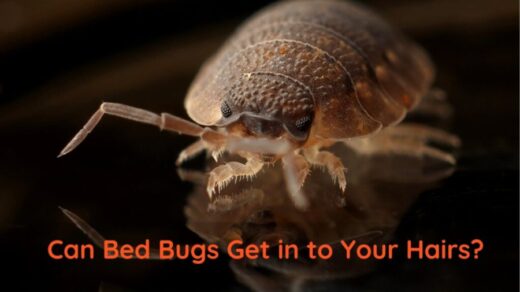How To Identify Bed Bugs ?
Bed bugs are small (Adults are approximately 4 to 5 mm long, size of an apple seed), oval shape, they have a flattened body, two antennae and six legs Reddish brown, with abdomen darker as blood is digested insects that feed on the blood of animals or humans.
Due to the flattened body of a bed bug they can easily hide in small places such as baseboards, cracks in floors, under carpets, behind loose wallpaper, bed frames, sofas, behind picture frames and many other places which makes them very difficult to detect. They tend to stay together and large infestations will give off a sweet but unpleasant smell.
Here are some ways to identify bed bugs:
- Look for bites: Bed bugs typically bite in a cluster or line on exposed skin, such as the arms, neck, or legs.
- Check for blood spots: You may see tiny blood spots on your sheets or mattress if bed bugs have been feeding on you.
- Look for fecal stains: Bed bugs leave behind dark, rust-colored stains on sheets, mattress, or nearby walls, which is their excrement.
- Inspect the mattress and bedding: Bed bugs often hide in seams, crevices, and folds of the mattress and bedding.
- Check the surrounding area: Bed bugs often hide in cracks and crevices in furniture, walls, and floors, so check those areas too.
If you suspect that you have bed bugs, it’s important to take immediate action to prevent the infestation from spreading. You can contact a pest control professional to help identify and treat the infestation.
Don’t Ignore These Key Signs of Bed Bugs
Here are some key signs of bed bugs to look out for:
- Bite marks: Bed bugs typically leave clusters of bites on exposed skin, such as arms, legs, or neck.
- Blood spots: You may notice small blood spots on your sheets, pillowcases, or mattress cover. These spots are a result of bed bugs being squished while feeding on you.
- Fecal spots: Bed bugs leave behind tiny black or brown fecal spots on surfaces such as your mattress, bedding, or walls.
- Cast skins: Bed bugs molt as they mature, leaving behind shed skins that may be found in areas where they hide.
- Live bugs: You may see live bed bugs, which are small, flat, and reddish-brown in color, crawling around on your mattress, bedding, or furniture.
If you suspect you have bed bugs, it’s important to take immediate action to prevent them from spreading. Call a pest control professional to inspect and treat your home if you find any of these signs of bed bugs.
Protect Your Home: Learn How to Spot Bed Bugs
To spot bed bugs in your home, here are some things you can do:
1. Inspect your Bedding: Check your sheets, pillowcases, and mattress for any signs of bed bugs, such as blood stains, fecal spots, or bed bug exoskeletons.
2. Look in cracks and crevices: Bed bugs often hide in cracks and crevices in furniture, walls, and floors. Use a flashlight to inspect these areas thoroughly.
3. Check your furniture: Look for signs of bed bugs in the seams, folds, and crevices of your furniture, including chairs, couches, and dressers.
4. Watch for live bugs: Bed bugs are small and flat, with a reddish-brown color. Look for live bed bugs crawling on surfaces, such as your mattress or furniture.
5. Use bed bug traps: You can purchase bed bug traps that use pheromones to attract and trap bed bugs. These traps can help you determine if you have a bed bug infestation.
6. Call a professional: If you suspect you have bed bugs, it’s best to call a professional pest control company. They can inspect your home and use the appropriate treatments to eliminate the bed bugs.
By being vigilant and knowing what to look for, you can spot bed bugs in your home and take steps to eliminate them before they become a bigger problem.
Are You Seeing Signs of Bed Bugs? Here’s How to Tell for Sure
Bed bugs are a common household pest that can be difficult to detect. If you’re seeing signs of bed bugs in your home, such as bites on your skin or blood spots on your bedding, it’s important to confirm whether or not you have an infestation. Here’s how to tell for sure:
- Inspect Your Bedding: Check your sheets, pillowcases, and mattress for any signs of bed bugs, such as blood stains, fecal spots, or bed bug exoskeletons.
- Look for live Bugs: Bed bugs are small and flat, with a reddish-brown color. Look for live bed bugs crawling on surfaces, such as your mattress or furniture.
- Use a Bed Bug Trap: Bed bug traps use pheromones to attract and trap bed bugs. These traps can help you determine if you have a bed bug infestation.
- Call A Professional: If you suspect you have bed bugs, it’s best to call a professional pest control company. They can inspect your home and use the appropriate treatments to eliminate the bed bugs.
Remember, early detection is key when it comes to bed bugs. By being vigilant and taking action promptly, you can prevent a small bed bug problem from turning into a larger infestation.
What To Do If Traces Of Bed Bugs Are Found ?
Do not
- Disturb the room further. Leaving the “scene” untouched will help Orkin Canada diagnose the problem.
- Take any items out of the room. Doing so will only help the bed bugs spread.
Do
- Stop using the room and “quarantine” it
- If the room is occupied, work with management to move guests to a new room
- Contact a professional pest control company immediately in order to inspect the infested room and/or pre-treat rooms to which any guests might be moved. In British Columbia you can only pre-treat when evidence of an infestation is found.
Habitat Diet & Behaviour
Bed bugs undergo gradual metamorphosis (egg, nymph, adult). Nymphs are smaller versions of the adults and will go through several molts until fully grown.
Females lay 200 to 500 eggs in her lifetime, 10 to 50 at a time, on rough surfaces. Eggs then hatch within 6 to 17 days, with adult bedbugs having the ability to survive over 1 year without feeding.
Here’s more information about their habitat, diet, and behavior:
Habitat: Bed bugs are found worldwide and can live in any environment, as long as there are humans or animals to feed on. They are commonly found in bedrooms and other areas where people sleep or rest, but can also be found in movie theaters, public transportation, and other public places.
Diet: Bed bugs feed on the blood of animals or humans. They are nocturnal and typically feed while their host is sleeping, biting exposed skin and injecting an anticoagulant to help the blood flow more easily.
Behaviour: Bed bugs are known for their ability to hide in cracks and crevices in furniture, walls, and floors during the day. They are attracted to warmth and carbon dioxide, which is why they are often found in beds and other areas where people sleep. Bed bugs can survive for several months without feeding, which makes them difficult to eliminate.
Getting rid of bed bugs is important to keep your home healthy and comfortable. You can take some steps to get rid of them. First, hire a pest control company to help. They will know what to do. Second, you can also help by washing and drying your bedding at high temperatures and vacuuming your room often. Doing these things will help prevent the bed bugs from spreading and getting worse.
Frequently Asked Questions
Q.1 Why Do I Have Bed Bugs?
A. Bed bugs can infest any home or building, regardless of how clean or dirty it is. There are several ways that bed bugs can enter your home, including travel, used furniture , visitors and shared laundry
At night, bed bugs feed on sleeping humans, but by day, they hide in dark undisturbed areas like inside furniture, baseboards, floorboards, carpets, and even wallpaper.
Bed bugs are sneaky pests that can hide in our things like suitcases, purses, and laptop bags. They can’t cling to people, but they can easily be carried around by us. This means that we can accidentally bring them into our homes, hotels, offices, hospitals, or any other building we visit.
Even if you keep your things clean, bed bugs can still find their way into your belongings. It’s important to know that having bed bugs doesn’t mean you’re not clean or tidy. Anyone can get them, no matter how clean they are. So, always be careful when traveling and inspect your belongings regularly to avoid bringing bed bugs home.
They are known to travel more than six metres from hiding in order to feed, but generally hide within two metres of their host, in large infestations that give off a sweet but unpleasant smell.
It’s important to note that having bed bugs does not necessarily mean that your home is dirty or unkempt. Bed bugs can infest any home, regardless of how clean or organized it is. If you do have bed bugs, it’s important to take immediate action to prevent the infestation from getting worse.
Q.2 Why Are Bed Bugs Back?
A. Lastly, with more people traveling internationally, bed bugs can easily hitch a ride in suitcases and bags and end up in new places. It’s important to be careful and check for bed bugs to avoid bringing them home.
Bed bugs are parasitic insects that live near their hosts. Since they feed on humans (their hosts) their habitats include houses, hotels, or any property that we frequent. All they require is a protected area in close proximity to a feeding source. Bed bugs bite people when they are sleeping usually on exposed skin.
When looking for a meal bed bugs can move very quickly to feed and then back into hiding after their meal. Bed bugs have been known to travel over 20 feet from hiding in order to feed but will generally hide within 3-6 feet of their host. Unless you know specifically how to look for bed bugs these pests can be easily overlooked.
Additionally, bed bugs are incredibly difficult to control and eliminate. They can hide in the tiniest cracks and crevices, making them hard to find and treat. This means that even if you take steps to prevent bed bugs, they can still find their way into your home and establish an infestation.
Overall, a combination of factors including the banning of powerful pesticides, increased global travel, insecticide-resistant bed bugs, and lack of awareness about bed bugs and how to prevent them have all contributed to their resurgence in recent years.
Q.3 How Worried Should I Be About Bed Bugs?
A. While bed bugs are a nuisance and can be uncomfortable to deal with, they are not known to transmit any diseases to humans. However, they can cause significant emotional distress and anxiety for those who have to deal with them. In addition, a bed bug infestation can be difficult and expensive to eradicate, especially if left untreated for a long time.
If you suspect that you have bed bugs, it’s important to take action as soon as possible to prevent the problem from getting worse. By being proactive and vigilant, you can prevent a small bed bug problem from turning into a larger infestation. This can save you time, money, and emotional stress in the long run.













